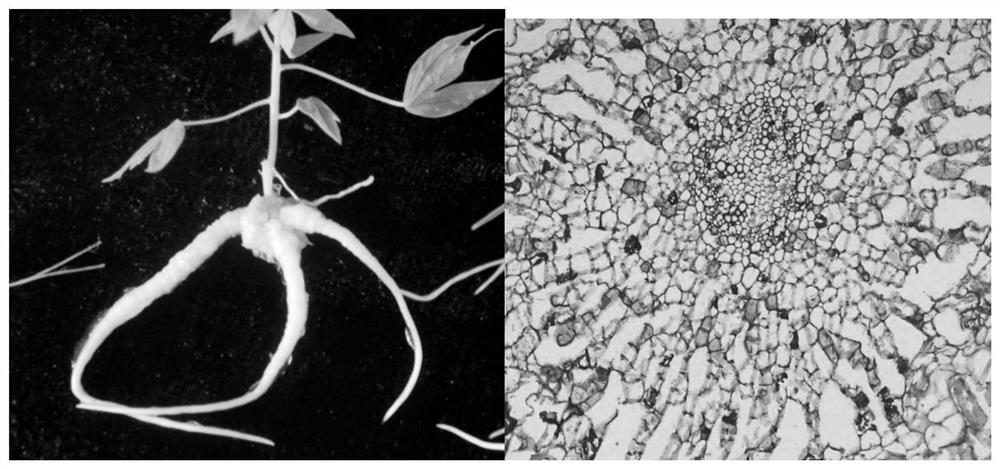Culture medium and method for inducing plant to form storage roots
A medium and basic medium technology, applied in the fields of botany equipment and methods, plant regeneration, horticultural methods, etc., can solve the problems of not obtaining cassava roots, not forming secondary structures, etc.
- Summary
- Abstract
- Description
- Claims
- Application Information
AI Technical Summary
Problems solved by technology
Method used
Image
Examples
preparation example Construction
[0132] The present invention also provides a method for preparing a plant medium, comprising mixing basal medium, 6-BA, NAA, sucrose and optional jasmonic acid compounds, the plant medium contains 0.05mg / L-0.2mg / L of 6-BA, 10-100 μg / L NAA, 2-6% sucrose, 1 mg / L-4 mg / L jasmonic acid compound, the jasmonic acid compound is jasmonic acid or its derivatives. The plant medium is used to induce plants to form storage roots. The plant is preferably selected from the group consisting of: sweet potato, cassava, Polygonum multiflorum, Dahlia, Asparagus, Poncea.
[0133] The present invention also provides a plant culture method for inducing a plant to form a storage root, comprising culturing a plant or part of a plant with the plant medium described herein. Plants having storage roots can be obtained using the cultivation methods herein. "Culture" as used herein includes various types of plant culture, such as tissue culture, plant culture, pot culture, and field culture. The tissue c...
Embodiment 1
[0160] Embodiment 1, the cassava root induced by different sucrose concentrations
[0161] The result of 2% sucrose concentration as figure 1 As shown, the primary root has a tendency to expand, but the root maintains the primary structure. There is no accumulation of starch granules in the root.
[0162] The result of sucrose concentration of 4% is as follows figure 2 As shown, the trend of root expansion has been very obvious, and the number of fibrous roots has increased. There is a large amount of starch accumulation in the roots of the plants (stained as dark parts), but the primary structure is still maintained.
[0163] The result of 5% sucrose concentration as image 3 As shown, the expansion of roots was inhibited compared with 4% sucrose treatment, and the number of wild-type fibrous roots increased. Section results showed that starch accumulation in roots disappeared.
Embodiment 2
[0164] Embodiment 2, the cassava root induced by different concentrations of NAA
[0165] The results of NAA concentration of 0.5μg / L are as follows Figure 4 As shown, the root has a tendency to become thicker, and the section results show that starch has accumulated in the root (stained as a dark part).
[0166] The results of NAA concentration of 10μg / L are as follows Figure 5 , the number of fibrous roots increased, the roots of the plant became thicker obviously, and there was starch accumulation (dark part stained).
[0167] The results of NAA concentration of 50 μg / L are as follows Image 6, there was an obvious swelling phenotype, and a small amount of starch accumulated in the swelling root, but it was still a primary root structure.
[0168] The results of NAA concentration of 100μg / L are as follows Figure 7 , the roots are all thickened or swollen, with a small amount of starch accumulation (stained as a dark part), but the cell structure of the root is loose....
PUM
 Login to View More
Login to View More Abstract
Description
Claims
Application Information
 Login to View More
Login to View More - R&D
- Intellectual Property
- Life Sciences
- Materials
- Tech Scout
- Unparalleled Data Quality
- Higher Quality Content
- 60% Fewer Hallucinations
Browse by: Latest US Patents, China's latest patents, Technical Efficacy Thesaurus, Application Domain, Technology Topic, Popular Technical Reports.
© 2025 PatSnap. All rights reserved.Legal|Privacy policy|Modern Slavery Act Transparency Statement|Sitemap|About US| Contact US: help@patsnap.com



